A long road to freedom: Despite risks of detention or death more women are finding ways to leave Afghanistan
By Sashikala VP, CNN
Fatima was sat on the floor of a room she was renting in Quetta, a city near Pakistan’s border with Afghanistan, using a notebook as a fan – her only respite from the July heat. As she fanned herself, she told CNN by video call about the three times she tried to flee her home country, Afghanistan – the second attempt much more violent than the first.
Fatima – whose name, like all the refugees in this story, has been changed as she is currently undocumented and not yet safely relocated – said she had been a serving officer with the Afghan National Army when Kabul fell on August 15, 2021. In the chaos that followed, she was unable to leave Afghanistan but months later, in January 2022, the young woman in her twenties journeyed to Iran from a city in northern Afghanistan – a trip she said took three days by foot. But as they approached the border, she and the group she was traveling with were spotted by Iranian border guards and shot at, so they fled. A month later, she tried again.
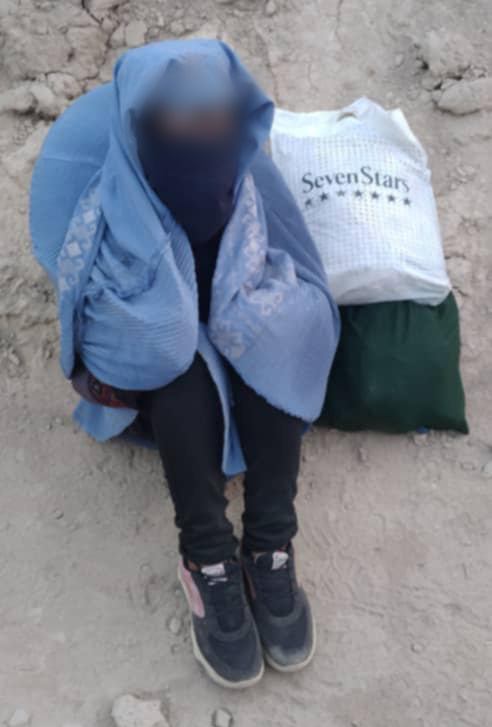
A picture of Fatima taken on her first attempt to enter Iran in early 2022. The image has been blurred by CNN to protect her identity. Obtained by CNN
This time, Fatima told CNN that she flew into Iran’s capital Tehran, entering on a visa she said she paid 45,000 afghanis ($640) to an intermediary to acquire for her. After a few months, she found smugglers who said they could get her into Turkey. But rather than facilitate her departure, Fatima alleges that they detained her and other migrants and demanded a ransom from their loved ones for their release. “We were physically assaulted regularly,” she said, raising her wrist to her mobile phone’s camera to show a visible protrusion. “It has still not healed,” she said of the wound.
About 20 days after her ordeal began, Fatima said she and other migrants were found by the Iranian police and were taken to a detention center. From there, despite trying to convince officials that her life would be in danger, she was put on a bus and returned to Afghanistan.
The worst wasn’t over. Fatima said the Taliban stopped the bus she was traveling on, and she was taken into custody. For three days they beat her and questioned her about her role in the army. Eventually word got back to her family who, she said, borrowed money to pay a $3,000 bribe to the Taliban for her release.
“They were threatening me and telling me I should be killed. I begged (saying) that I am the bread winner (of the family), I am the eldest child”, she said, speaking quickly as though afraid she would forget some detail if not immediately shared.
Her teenage sister, Azra, who CNN spoke to separately, said she was there the morning Fatima finally made it back home. “She was covered in blood”, Azra recalled. “When I saw her, she was crying. Our mother bathed her, while I made her some food.”
Despite talking for hours, Fatima’s account of what happened to her in Iran is patchy. She told CNN she suffers from memory loss as a result of the beatings she received to the head. CNN has also omitted some of the specifics of her journey so as not to expose these routes.
Still, a 2022 report by Amnesty International does detail experiences of Afghan refugees that mirror some of what Fatima described: of using smugglers, being fired upon at the border and of detention and deportation.
At the start of 2023, Fatima attempted once again to leave Afghanistan. This time she enlisted the help of a smuggler and successfully crossed into Pakistan. By the time CNN spoke with her, from that small room in Quetta, she was visibly traumatized by her first two journeys, angry with international agencies who she feels let her down, and still desperate to get to safety: in November 2023, the government of Pakistan ordered hundreds of thousands of Afghan refugees to leave the country.
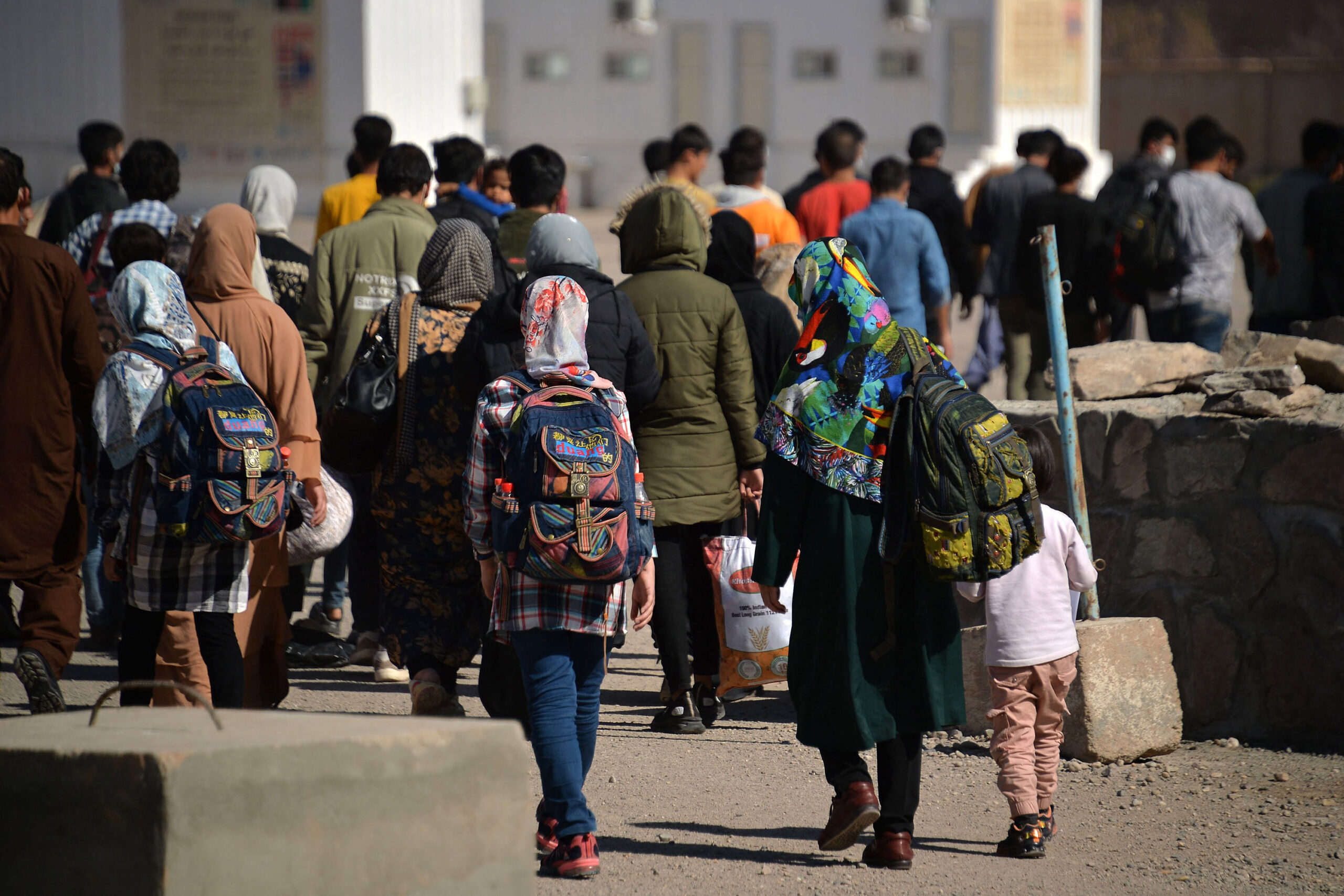
Afghans walk towards the border between Afghanistan and Iran at Islam Qala port after being forcibly deported from Iran on October 19, 2021. Hoshang Hashimi/AFP/ Getty Images
Afghanistan has a long and painful history of violence and displacement. Over the past 40 years, millions of Afghans, predominantly men and boys, have fled their country in search of safety and economic opportunity. They have ended up in large numbers in neighboring Pakistan and Iran, but many have also made it further afield to Turkey, Western Europe, the US or Australia.
Since the Taliban’s return, however, a new phenomenon has emerged: the number of female refugees per year has more than doubled, according to data from the UN Refugee Agency (UNHCR).
In 2023, there were more than 3.1 million female Afghans who were classified as one of four categories of individuals outside their home country, seeking or have been granted international protection – which we refer to broadly as refugees. In 2021, there were approximately 1.2 million such women and in 2020, the number was around 800,000.
There are now more female Aghan refugees than at any time in the past 20 years. As the Taliban’s violations against women continue – violations the UN has said “amount to crimes against humanity” – and with the restrictions it has imposed on women’s freedom of movement, non-governmental organizations are sounding the alarm that greater numbers of women and girls will be forced to take land routes – as Fatima did – risking extortion, physical and sexual violence, detention and even death as they attempt to flee Afghanistan.
Migration, the only lifeline
“When migration is the only lifeline available, all efforts must be ensured to provide safe passage,” noted the Mixed Migration Centre (MMC), a non-profit that collects migration data, days after the fall of Kabul.
Two years later, reviewing all the restrictions the Taliban has imposed on women and girls, the same organization wrote: “This new reality, compounded by a growing fear of persecution under the Taliban, rising food insecurity, and worsening poverty levels in the country, will affect migration dynamics for some time to come, particularly in terms of women’s mobility.”
It went on to call for “appropriate and focused action on the specific risks” Afghan women faced as they migrated and once they’d reached “a host country.”
Life for women and girls under the Taliban has been well documented. From the ban on secondary school and university attendance for girls, to employment restrictions, the closure of beauty salons which employed some 60,000 women, and a ban on long-distance road trips and then flights for women without a male chaperone.
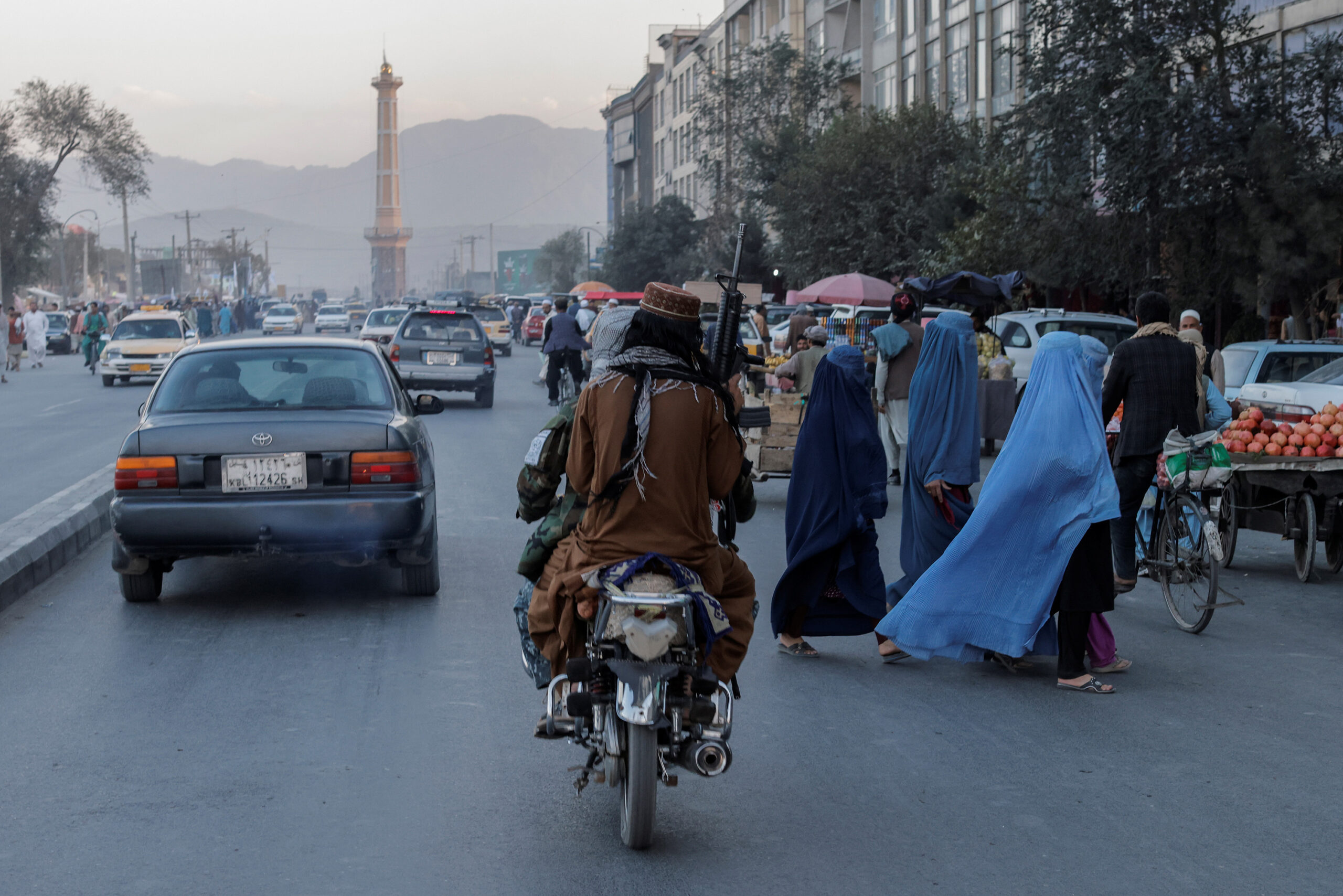
A group of women wearing burqas crosses the street as members of the Taliban drive past in Kabul, Afghanistan, on October 9, 2021. Jorge Silva/Reuters
Speaking to CNN a year ago, Afghan women’s rights activist Mahbouba Seraj said: “The women in Afghanistan are being slowly erased from society, from life, from everything.”
Afghan women refugees in Turkey also spoke of this erasure. In interviews conducted by MMC between August 2021 and September 2023, women who left after August 2021 indicated that after “conflict”, the loss of “rights and freedoms” was what had motivated them to leave. The research, published in April, also reported “an increased reliance on land routes” among the women surveyed, attributing this to “the Taliban’s prohibition on Afghan women from boarding flights unaccompanied by a male guardian.”
Despite the challenges, UNHCR reported a 57% increase in the number of Afghan women and girls entering Iran in the first three months of this year compared with the same period the previous year. Numbers in 2023 were 8% higher than those in 2022. But these journeys, as Fatima’s story shows, are not without significant risk.
Of the risks perceived by the women MMC surveyed, the top three were: physical violence, detention, and death. “Ill-health from harsh conditions” had been a bigger risk than detention for women who left before August 2021.
Afghan women migrants to Turkey who were interviewed after August 2021 also identified who they saw as perpetrators of these risks, with border guards/ immigration officials, smugglers, and military/police in the top three.
Not everyone lives to tell the tale. The International Organization for Migration (IOM) collects data on dead or missing migrants. Though the numbers are very small, they too are rising.
In 2020, the IOM’s Missing Migrants Project recorded 5 deaths or disappearances of Afghan women while migrating. (For this story CNN includes only deaths reported by official sources.) By 2023, the number had increased to 85, and in the first three months of 2024 alone, 51 Afghan women had already been reported to have died or disappeared.
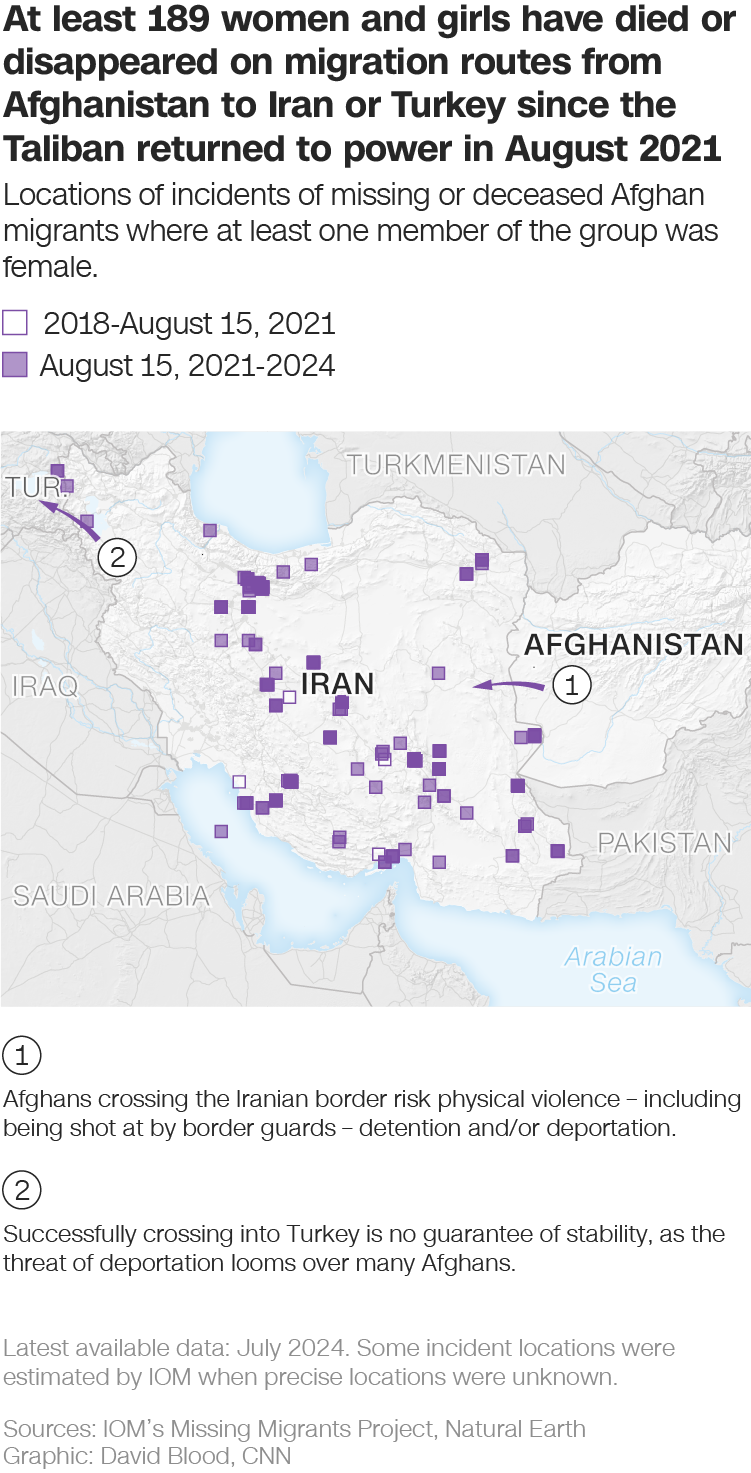
'It’s not easy for an Afghan woman, but you must take risks’
Even when the risks are known, desperate families are choosing to take them anyway.
Despite nursing back to health one child who had been met with brutality as she tried to get to safety, and then losing contact with her once she’d entered Pakistan, Fatima’s mother decided last year that Azra would also leave the only country she had ever known with her younger brother, Ismael.
Azra told CNN that she was given 15,000 afghanis (approximately $213), money her mother raised in part from the sale of her sewing machine. Most of it went to paying the smugglers who would facilitate the children’s journey south into Pakistan without visas.
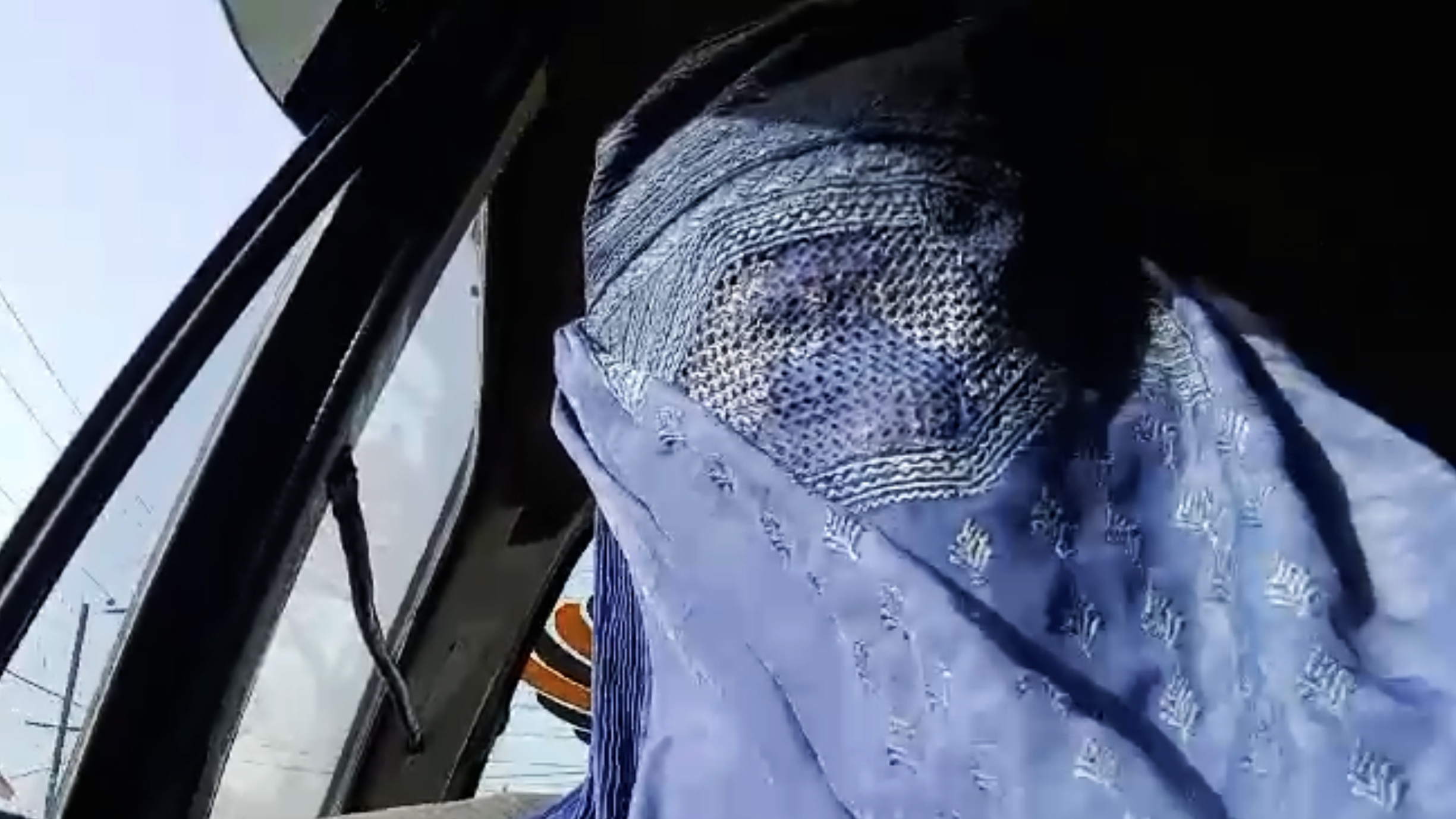
Azra on the first leg of the more than 1000km journey to escape Afghanistan. Obtained by CNN
This too was a journey over land, which took two nights and days across more than a 1000km (about twice the length of New York State), with the siblings passed between multiple smugglers. Azra told CNN they left home before sunset on June 1, just months after Fatima, traveling first in a taxi then on a night bus to Kabul, through Afghan cities ravaged by fighting between the Taliban and government troops years earlier. Then it was on to the Afghan border town of Spin Boldak, where a final exchange was made with smugglers who took them over the border into Chaman in Pakistan.
The Chaman-Spin Boldak crossing is a vital trade route between both countries, with travel in vehicles, on foot or on animal back. Azra described the border as “utter chaos with thousands waiting and crossing.” She said the smugglers asked them to hand over their mobile phones and other expensive possessions, warning that the border police at check points would take anything they find.
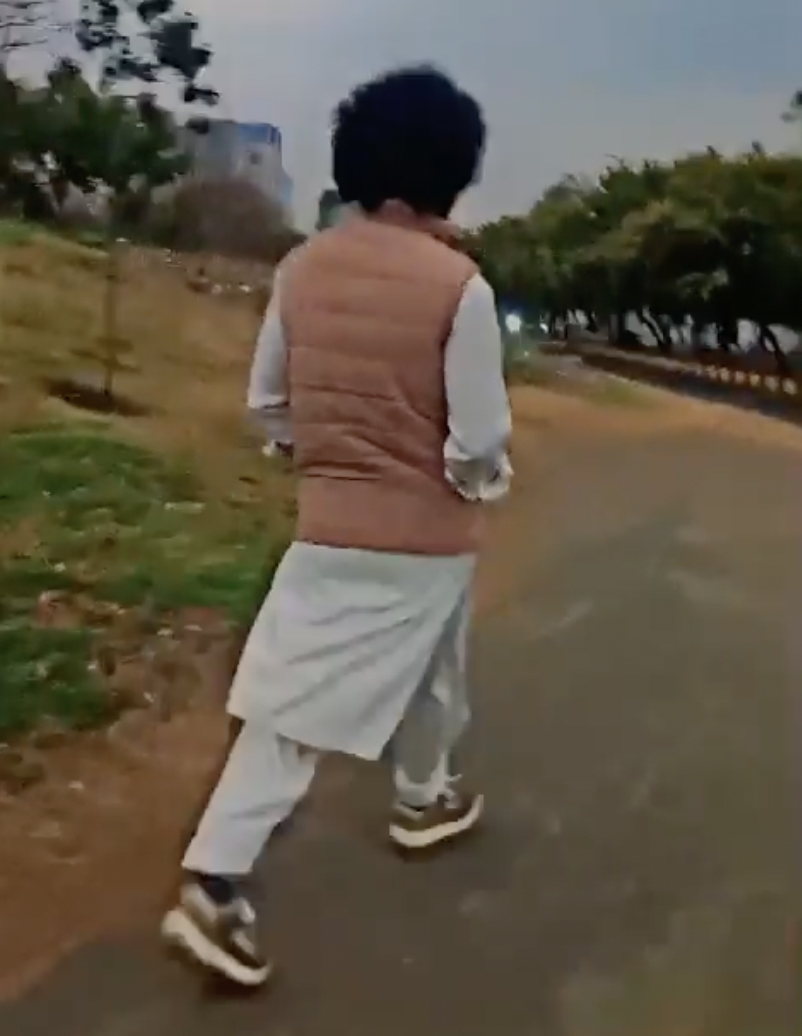
A screengrab from a video taken by Azra, as Ismael walks ahead. The siblings were on their way to the Afghanistan embassy in Islamabad. Obtained by CNN
In the chaos Azra said she lost contact with her brother, who is also in his mid-teens. The children, who were later reunited, are Hazara, an ethnic minority which has faced violent persecution by the Taliban. According to Azra, her brother’s features are recognizably so, making him a possible target at the border. “I was wearing the chadari (the Afghan version of a burqa, which covers the wearer fully, including over the eyes) and so could enter,” Azra said. “But I lost my brother.”
“I didn’t know where he was, I was crying and begging ‘please find him!’.”
The young siblings were reunited two days later in Quetta, which for decades has housed hundreds of thousands of Afghan refugees. And, it would be several months before Fatima joined Azra and Ismael in Pakistan’s capital city Islamabad, where she is now attempting to get the travel documentation required for all three to hopefully immigrate to the West.
Of what they have endured, Azra told CNN that her older sister “has suffered more than each of us.”
Anxious to find a way out of Pakistan and haunted still by what she experienced, Fatima’s message to other Afghan women is that if they want to leave, they should. “The migration path is difficult, and people lose things in many ways,” she said.
“It is not easy for an Afghan woman to do it. But you must take risks to reach your destination.”
And the UN Refugee Agency estimates that women will continue take risks to live and learn more freely.

Afghan nationals cross the border into Pakistan in Chaman on August 18, 2021. AFP/Getty Images
Spokesperson Shabia Mantoo warned that “an uncertain future is likely to continue for women and girls in Afghanistan.” With the opportunity for Afghan girls to go to school and university Mantoo told CNN: “We anticipate Afghan refugee women and girls will continue to come to Iran.”
Meanwhile in Pakistan and Turkey, where the fear of deportation continues to loom large over Afghan refugees, various non-governmental organizations told CNN that the international community needs to do much more. “The repressive policies imposed by the Taliban have forced many women and girls to seek safety and better opportunities elsewhere, often through perilous means,” said Zakira Hekmat, founder of Afghan Refugee Solidarity Association in Turkey – a country that hosts nearly 120,000 Afghan refugees and asylum seekers.
Hekmat said the international community must establish and enforce “safe routes for refugees, especially women” and provide them with “legal avenues for asylum and resettlement and ensuring that border policies do not expose women to further harm.”